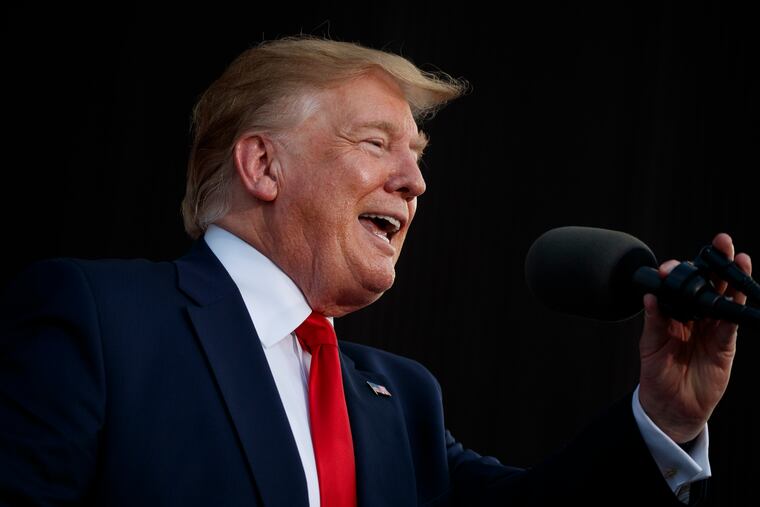A U.S. recession is a possible scenario if the trade war with China escalates
Just a few weeks ago, expectations were strong that an agreement ending the war, or at least putting it on hold, was imminent. But suddenly a number of darker scenarios seem possible, even one in which we suffer a recession.

President Donald Trump has upped the ante in his trade war with China, wrong-footing nearly everyone by the move. Just a few weeks ago, expectations were strong that an agreement ending the war, or at least putting it on hold, was imminent. But suddenly a number of darker scenarios seem possible, even one in which we suffer a recession.
It is unclear what prompted Trump to raise tariffs on $200 billion in Chinese imports from 10 percent to 25 percent. And another $50 billion in Chinese imports already have a 25 percent tariff. Trump has suggested that the Chinese were backtracking on provisions of the trade deal he was negotiating with them. The president may also be engaged in some brinkmanship, as he appears emboldened by the resilient U.S. economy to extract concessions from China.
The reaction in financial markets has been modest so far. Stock prices are down only a few percent from the record high set just prior to Trump’s tariff hike. Investor expectations remain strong that the U.S. and China will soon come to terms.
This seems the most likely scenario. Given the difficult progress in the discussions up to now, the costs to the economy and stock market if the war drags on, and Trump’s innate desire to deal, odds are that some type of arrangement will be struck by the end of June, when both Trump and Chinese President Xi Jinping will be at the G20 meeting in Japan.
If so, the 10-year old economic expansion will continue. Our economy will be diminished by Trump’s trade policies, but it will not be bowed by them.
Complicating things, however, is Trump’s recent decision to put Huawei, the massive Chinese telecommunications company, on the so-called entity list of foreign firms that American companies need U.S. government permission to do business with. This is not just a slap at Huawei. Because the company is an iconic symbol of China’s economic success, it is also a slap at Chinese national pride.
If nationalism infects the trade discussions, an all-out trade war may very well ensue. This would include Trump putting a 25 percent tariff on all Chinese imports to the U.S. — about a fifth of all our imports. The higher tariffs would hit the U.S., Chinese and global economies hard. Businesses can navigate around the impact of a 10 percent tariff — they can reduce their profits, pass along some of the costs, and source their imports from different countries — but navigating around a 25 percent tariff would prove impossible. Global supply chains will be severely disrupted.
You and I will feel the ill-effects of the trade war for the first time, because we will have to pay much more for many of the things we buy from Walmart or Amazon. So far, the tariffs have been largely on items that businesses use. But if the war escalates, prices for everything from clothes to toys will jump.
And China won’t take it lying down. It will almost certainly retaliate by raising tariffs on U.S. exports to China, making it more difficult for U.S. businesses to obtain regulatory approvals, or delaying customs clearance for U.S. goods. It could even allow the yuan to depreciate further in value, as it did last year when the trade war first broke out.
An even more extreme step would be for China to stop selling rare earth metals that only it has in large quantities, and that are critical to the production of high-tech goods. Or the Chinese could boycott U.S. goods altogether, as they did Japanese cars a few years ago. Imagine what would happen to the U.S. stock market if the Chinese stopped buying iPhones.
And then there is the nuclear option: China could unload its massive holdings of U.S. Treasuries, which would cause our interest rates to spike. The likelihood of going down this dark path still seems low, but it is a recipe for a U.S., Chinese and global recession later this year.
The Federal Reserve would attempt to cushion the economic blow by cutting rates, and the Chinese would pump up monetary and fiscal stimulus. However, these efforts would fall short. The length and depth of the downturn would depend on how long it takes Trump to ultimately call a truce.
There is good reason to engage China on its trade practices and generally poor behavior in international commerce. But, Trump’s trade war is a costly and likely ineffective way of getting China to reform. There is a general consensus that Trump won’t push it too far.
Once it does show up in lower stock prices and weaker U.S. growth, he will relent. This makes sense, but it is important to carefully consider alternative scenarios.